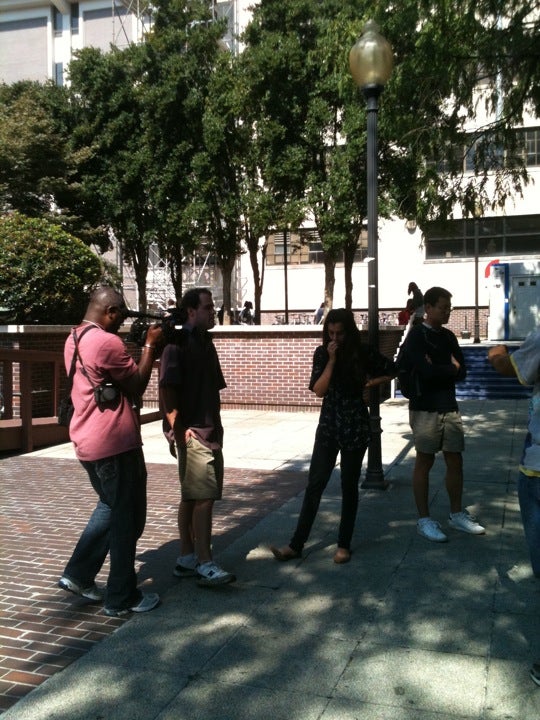Post: Primary
This widget area is currently empty. You can add widgets to this area via your admin widgets page.
Examples of some widgets you can add are shown below.
Examples of some widgets you can add are shown below.
Sep
30
Sep
29
The design of the Georgia State University “quad” discourages unity. The arrangements and designs of the flower pads, light poles, signs, long and narrow stairways, horizon, structure, trees, trash cans, and the fountain pool, are all contributing factors of the discouragement the court yard causes for unity.
The design of the Georgia State University Court Yard provides obstacles to unity among students in many ways: The space should be an open wide area, but it is separated by those irremovable flower pads, light poles, signs, and bulletin stands. A walking group of students has to split in different directions to avoid running into those objects. The entrances to the buildings around the “quad” are either lower or higher in horizon. The stairs to the doors from the “quad” are stretched long only sideways, but not wide enough for students who want to stay out door to work with their laptops. Some trash cans occupy the space below the stairway from Court land Street. The fountain pool in the middle of the “quad” is the main source of group separation. Students don’t always stay together once they come from the library trying to access the Lawn dale Hall Building. The Georgia State University “quad” should be spacious, but the structures and arrangements of the objects on its land make the Court Yard to be congested.
Sep
28
Serving the public takes a lot of patience and discipline, especially in large city like Atlanta. To be a successful in public service career such as bus driver, security, etc, one needs to have an intensive training on how to serve the public. Around down town Atlanta, those routes are really the ones, including some Metro routes, that pull out the requirements of the professional bus drivers among the variety of people that ride those buses. It takes certain people to be in public service especially in the transportation industry in diversified area like Atlanta. For example, on route 186 which runs from down town Atlanta to Wesley Charper in Panola, a man argued unreasonably for paying $2.50 for bus fare. He stood by the door way to stop the bus from moving. He held the bus for about 6 minutes. And I had to call Marta police before the departure was possible. Bus drivers are usually trained to stay calm to deal with this kind of situation and get authority involved. Serving in public transportation involved dealing with criminals, violent people, drunkers, and mostly low income people, etc.
Around down town Atlanta, those routes are really the ones, including some Metro routes, that pull out the requirements of the professional bus drivers among the variety of people that ride those buses. It takes certain people to be in public service especially in the transportation industry in diversified area like Atlanta. For example, on route 186 which runs from down town Atlanta to Wesley Charper in Panola, a man argued unreasonably for paying $2.50 for bus fare. He stood by the door way to stop the bus from moving. He held the bus for about 6 minutes. And I had to call Marta police before the departure was possible. Bus drivers are usually trained to stay calm to deal with this kind of situation and get authority involved. Serving in public transportation involved dealing with criminals, violent people, drunkers, and mostly low income people, etc.
Sep
26

Sep
26
Sep
23
I spent time with some students in the computer lab on Tuesday, September 21 studying the technical aspect of my English 1102 class. Even though I was off from school.
Sep
23
Sep
13
Part I of this article is about how the built Environment can impact and shape our behaviors and actions. It is an unseen power instrument designed to regulate our behavior. The Built Environment is as powerful as law because it “allows the government to shape our actions without realizing the fact that our experience has been deliberately shaped”. The article is about the literature that talks about infrastructure placement and format symbolic or physical contributors to economic and social inequality, exclusion, and isolation in society. These concepts are fundamentally structured for planners and architects to use. Yet, only a small number of legal scholars consider the regulations or the role that the Built Environment impose on us. Law makers and Judges should be diligent when analyzing the exclusionary impacts of architecture, but research indicate that they often give these impacts little or no consideration.
Part II of this article spots out the different ways the practice of architectural exclusion by municipalities through actions from different participants that create infrastructure to restrict passage and access to certain areas of the community. Those Built Environs that create impediments for access to certain community include: low bridges, road closings, construction of walls, and parking-by-permit-only requirements. The author of this article is making a genuine argument; and her points are very productive of discussion. There are reasonable explanations and points that she made in both parts I and II to allow her audience(s) to think rhetorically about the action of the Built Environment in our community.
Sep
12
la la la la la
Sep
9
1.1: rhetoric is the act or skill of speaking or writing formally and effectively to persuade or influence people.
1.2: rhetoric is sweet talk to impact people’s behavior.
1.3: grandiosity- the grandiosity of her expertise has impacted the institution. It is a “positive” word. This word tells the positive impacts that rhetoric make.
1.4: Columbusing: The act of appropriating without acknowledgement a cultural attributed with an ethnic group other than one’s own.